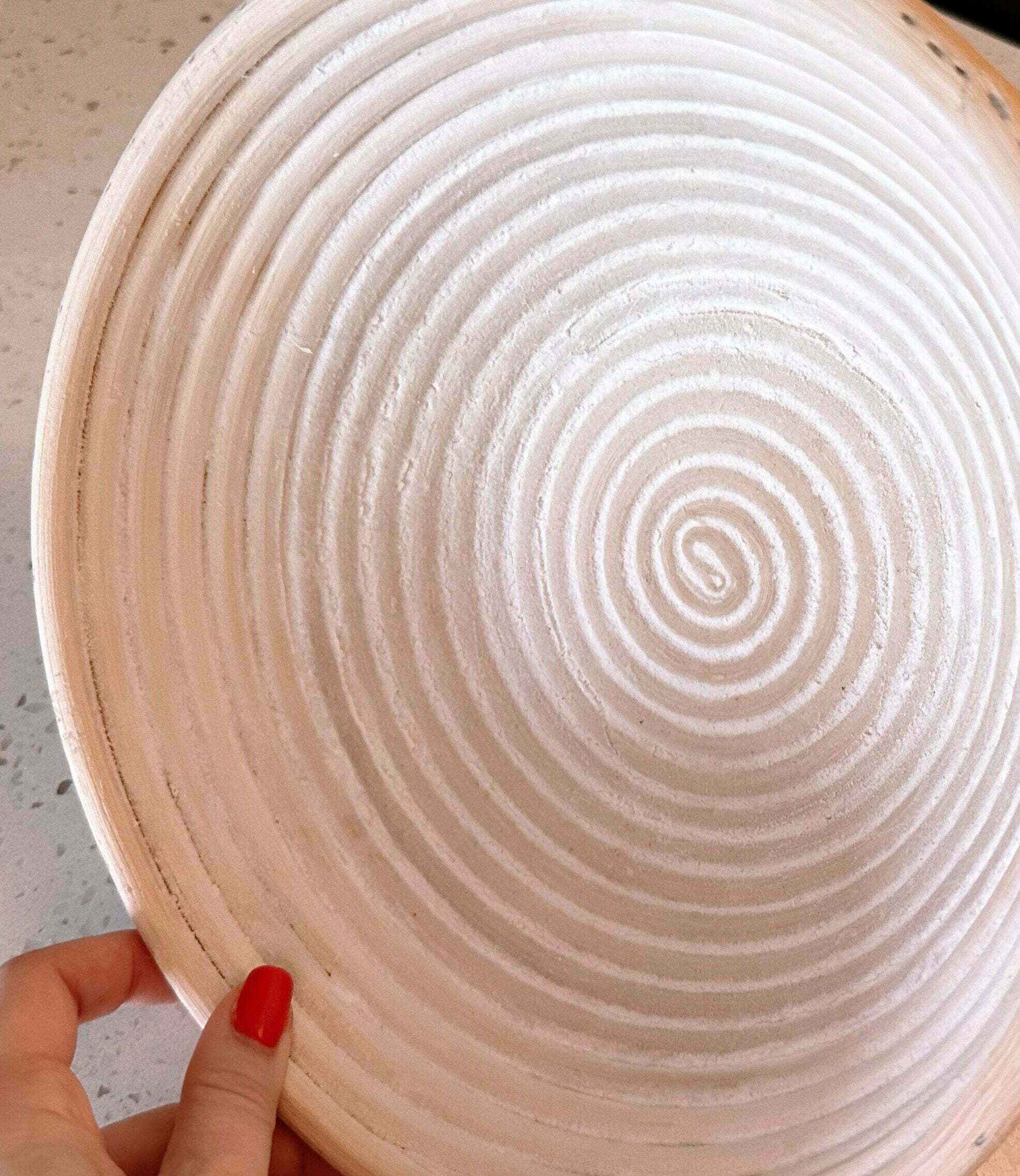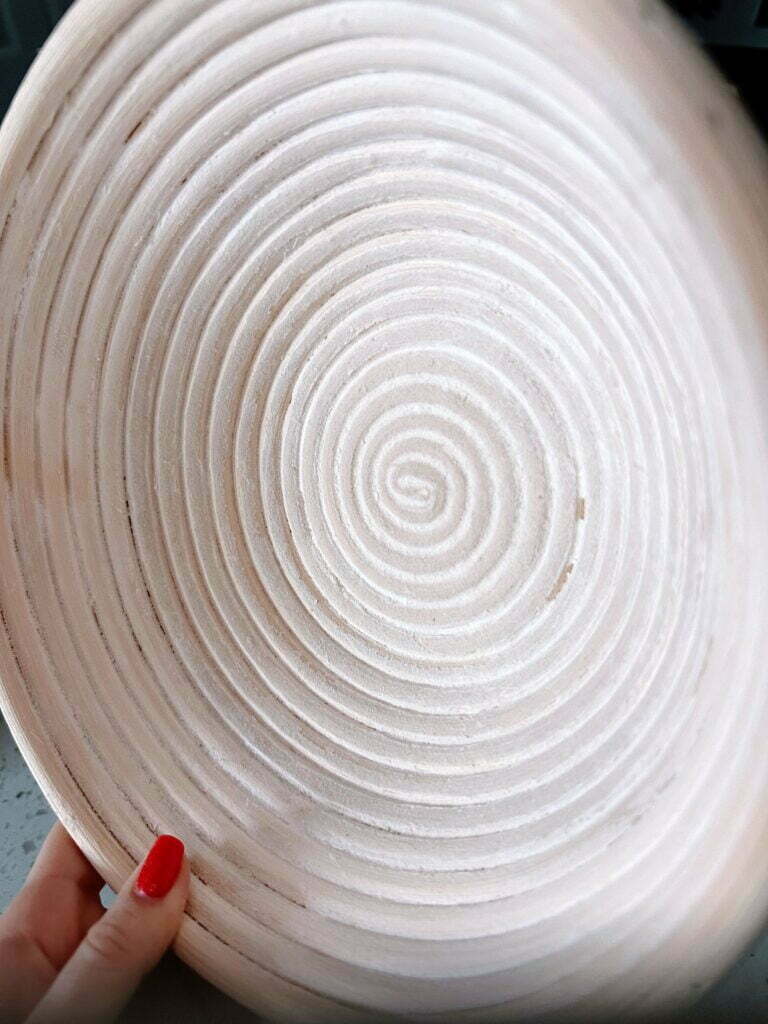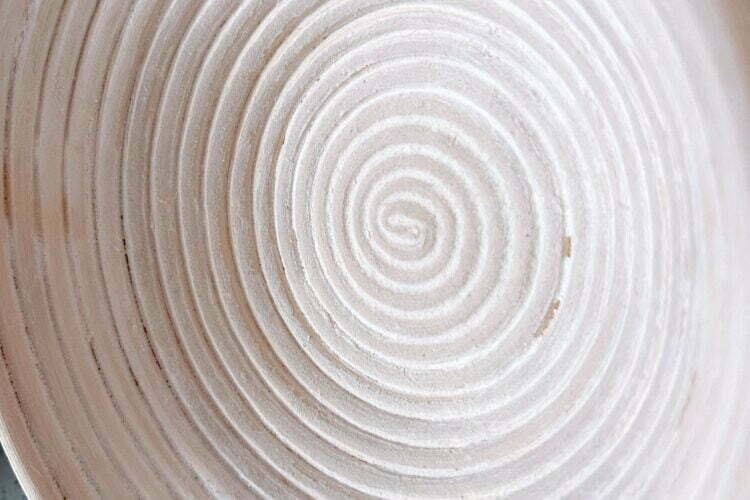1. What is a banneton?
Bannetons are often used in artisanal breadmaking to help maintain the dough’s shape and create a beautiful pattern on the bread’s crust. The basket’s texture and shape leave imprints on the dough, giving the bread a rustic and traditional appearance.
To use a banneton, you typically dust it with flour to prevent the dough from sticking. Then, after shaping your bread dough, you place it in the banneton for the final rise. The basket provides support while allowing the dough to breathe and rise evenly. Once the dough has sufficiently proofed, you can gently transfer it from the banneton to a baking surface or peel for baking.
After use, it’s important to clean and thoroughly dry the banneton to prevent any mold or bacteria growth. Some bannetons can be gently washed with water, but others should only be brushed clean and allowed to air dry.
Bannetons come in different sizes and shapes, allowing you to create various bread shapes and sizes. They are widely available in kitchen supply stores or online, and they are a popular tool among home bakers and professional bakers alike.
History of proofing baskets
The use of bannetons in breadmaking can be traced back to ancient times, particularly in European breadmaking traditions. The exact origin of bannetons is unclear, but they have been used for centuries as a tool to shape and support bread dough during the final proofing stage.
Bannetons were traditionally made from natural materials such as cane, rattan, or willow, which were readily available and provided a suitable environment for dough fermentation. These materials allowed air circulation and moisture absorption, which helped create a desirable texture and crust in the bread.
In many European countries, such as France and Germany, bannetons have been integral to the traditional methods of breadmaking for generations. The use of bannetons in these regions was passed down through generations of bakers, contributing to the development of specific bread shapes and styles associated with different regions.
The popularity of bannetons has spread beyond Europe, and they are now widely used around the world by both amateur and professional bakers. With the rise of artisanal breadmaking and the growing interest in traditional baking techniques, bannetons have become a common tool in many bakeries and households.
In recent years, bannetons have also seen some innovations in their design and materials. While traditional cane or rattan baskets are still widely used, bannetons made from alternative materials such as plastic or linen-lined baskets have become available. These alternatives offer easier maintenance and cleaning while still providing similar shaping and support for the dough.
Overall, bannetons have a rich history in breadmaking, representing a connection to traditional baking methods and adding a distinctive touch to artisanal bread. Their continued use and popularity today are a testament to their effectiveness in achieving well-shaped and visually appealing loaves of bread.
3. What was before bannetons?
Before the use of bannetons, various methods and tools were employed to shape and support bread dough during the proofing stage. The specific techniques and tools varied across different cultures and time periods. Here are a few examples:
- Wicker or reed mats: In some regions, bakers would shape and proof their dough on wicker or reed mats. These mats provided a surface for the dough to rest on and prevented it from spreading out too much during proofing.
- Cloth-lined bowls or baskets: Bakers would line bowls or baskets with cloth to create a suitable environment for the dough to rise. The cloth would be heavily floured to prevent sticking, and the dough would be placed in the lined container to proof.
- Wooden troughs: In large-scale bread production, wooden troughs were used to hold and proof the dough. The dough would be placed in the trough, allowed to rise, and then divided and shaped before baking.
- Hand-formed shapes: In some cases, bread dough was simply shaped by hand without the use of any specific tools or containers. Bakers would shape the dough into desired forms such as round loaves, oblong shapes, or braids.
It’s important to note that the use of these methods predates the widespread availability of bannetons. As baking techniques and tools evolved, the purpose-built bannetons or proofing baskets gained popularity due to their ability to support the dough’s shape, allow for air circulation, and create decorative patterns on the bread’s crust. Bannetons have become a preferred tool for many bakers due to their effectiveness and ease of use in shaping and proofing dough.
4. How Bannetons Shape Bread
Functionally, the banneton is a sculptor of structure. As dough undergoes its final rise—called proofing—it gently expands into the contours of the basket. The banneton supports slack doughs, particularly those with high hydration, preventing amorphous sprawl and encouraging vertical lift. This yields a lofty, elegant boule or bâtard with characteristic ridges and flour-dusted patterns.
But beyond structure, the banneton imparts a sensorial signature. The lined spirals etch delicate whorls into the dough’s skin, producing not only tactile beauty but also visual nostalgia—rustic rings that harken back to pre-industrial baking.
5. The Artisanal Renaissance
Though nearly eclipsed during the industrialization of baking—when mechanized pans replaced handmade baskets—the banneton has witnessed a resplendent resurgence in the 21st-century artisan movement. Home bakers and micro-boulangeries alike now cherish it as a talisman of authenticity.
In sourdough culture particularly, the banneton is more than a mold—it is an heirloom of ritual. From dusting with rice flour to transferring with swift, practiced motions, each step affirms the baker’s reverence for time, temperature, and tactile nuance. It is this ritualistic choreography that makes the banneton not merely a tool, but an artifact of craft.
6. What banneton is best? Material Matters: From Classic to Contemporary
Today’s bannetons come in diverse materials—wicker, wood pulp, plastic, even linen-lined options for gentler releases. Each choice impacts the dough subtly: wood pulp absorbs more moisture, promoting sharper crusts; plastic, while durable, offers less breathability. Choosing a banneton is like choosing a musical instrument—it must resonate with the baker’s rhythm and repertoire.


8. How to clean Banneton? Cleaning and Maintaining Your Banneton
For all its rustic charm, the banneton demands a curious blend of neglect and devotion. Unlike gleaming stainless-steel tools that yearn for soap and polish, the banneton thrives in a state of dusty sanctity. Its maintenance is not scrubbing—but stewardship.
No Soap, Just Ritual
Washing a banneton with water and detergent is not only unnecessary—it’s sacrilegious. The natural fibers (especially in cane or rattan baskets) are highly absorbent and can retain moisture, leading to mold or warping. Instead, bakers rely on a brush or stiff bristle to whisk away residual flour and dried dough. Think of it less as cleaning, more as gentle exorcism.
The Flour Coat: A Living Patina
Over time, a banneton develops what seasoned bakers affectionately call a patina—a thin, chalky layer of flour embedded in the grooves of the basket. This is not dirt, but a badge of honor. It acts as a nonstick shield and flavor memory, seasoning the banneton much like a cast-iron skillet. Regular flouring—particularly with rice flour for its low stickiness—both protects and enhances this layer.
Sunlight and Sanity
Should your banneton become suspiciously damp or develop any musty aromas, allow it a cleansing sunbath. A few hours of sunlight, or a stint in a low oven (no more than 200°F / 93°C), will evaporate lingering moisture and kill off unwanted microbial squatters. Just be cautious not to scorch the fibers.
Liner Care
If you use a cloth liner—common with very wet doughs—it can be gently hand-washed and air-dried. But many bakers find that rotating two liners, allowing one to fully dry while the other’s in use, extends their lifespan and keeps proofing consistent.
Signs of Retirement
A banneton’s life is long, but not eternal. Cracked coils, persistent mold, or strange odors may signal it’s time to retire your basket. But even then, many bakers hang their old bannetons on the wall—a symbol of loaves past and a quiet homage to a faithful companion.





